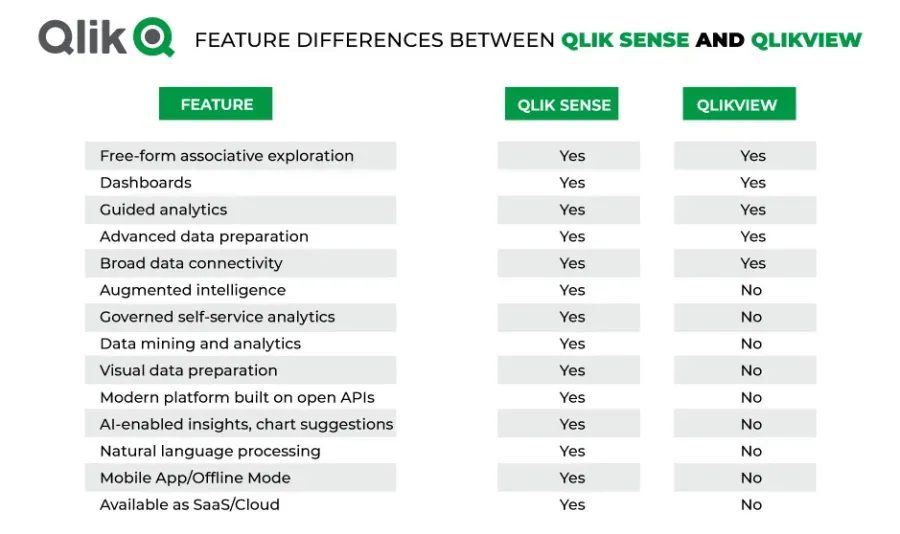For well over a century, the concept of and approach toward business intelligence has evolved significantly, progressing from just manual processes to more sophisticated scientifically gathered data and research tools. As the third wave of data analytics technologies sweeps the world, companies are gearing up to retire QlikView® and move on to Qlik Sense® for a faster and more visually powerful BI experience. Let’s take a look at various Qlik data integration touchpoints to consider while migrating from QlikView.
The Era of QlikView
QlikView was and still is, a very powerful BI tool. In fact, it essentially revolutionized self-service analytics and helped businesses broaden their analytics user network. QlikView played a fundamental role in replacing traditional analytics technology with more visually interactive and user-friendly dashboards.
But with an increase in demand for more visualization-enabled data tools that can accommodate non-technical business users, companies are already on the lookout for better alternatives. Built on the Qlik Associative Engine, QlikView remains as powerful and fast as its modern counterparts and can still support application development and data administration but lacks the easy-to-use UI and improved graphics that modern BI tools offer. With market dynamics and consumer preferences changing as rapidly as they are today, it is only fitting that companies adopt more easy-to-access data tools that promise to reduce dependency on and cost of skilled labor like data experts.
Differences between QlikView and Qlik Sense
Qlik Sense is the next-generation data platform by Qlik®, designed with more data visualization capabilities weaved into its AI/ML core to offer a more intuitive and easy-to-access interface. As opposed to QlikView, which was best suited for developers and data scientists who were highly skilled, Qlik Sense allows non-technical users with business and product knowledge to easily decode business data and leverage it to refine strategies in real-time. If your company is considering an upgrade from QlikView, here are some of the Qlik Sense features you might find valuable.
Visual Data Preparations
Of all its features, the one that truly sets Qlik Sense apart is its powerful visualization capabilities. Using Qlik’s Associative Difference®, the platform links relevant data values with each other and provides multiple filters and data representation forms that allow for a better understanding of analytical insights.
Governed Self Service Analytics
With Qlik Sense, businesses can have a more direct, problem-solving approach toward analytics, resulting in faster, more agile, and more effective analysis. The platform lets businesses define models based on what is required and put the right resources and processes behind them.
Augmented Intelligence
By combining the best of human curiosity and instincts with artificial intelligence, Qlik Sense empowers businesses to deliver value analytics faster, create more relevant data sets and translate business insights visually and in natural language.
Built on Open APIs
Qlik Sense APIs that are created using modern languages, styles, and libraries, allow businesses to integrate the platform with web applications, business tools, and other technologies. Data can be freely exchanged between Qlik Sense and other web applications.

Scope of Migration to Qlik Sense
The most important thing to remember about moving your analytics processes to Qlik Sense from QlikView is that both platforms are built using the same associative architecture. Hence, the tools share a lot of common features and reusable parts, which makes transitioning from one to another a whole lot easier than experimenting with a different BI tool. The key differentiator is the front-end UI of Qlik Sense which is much more interactive, powerful, and visually engaging.
The good news is that QlikView comes with a built-in converter tool that can help you transfer the visualization layer from the QlikView dashboard to Qlik Sense. The tool will update the new master libraries and even rebuild identical dashboards in the new platform. However, the converter is not without limitations when it comes to data migration – but nothing that an expert Qlik data integration partner can’t help you fix. Here are some of the objects that the converter tool will not be able to process for migration:
- Containers
- Triggers
- Macros
- Conditional statements
- Text boxes
- Object layers
- Custom chart colors
- Expression in list boxes
Plan your Qlik Sense Migration with Expeed
Now that you understand why your business should move to Qlik Sense and what that means for your existing data, let’s talk about the “how.”
Step one is, of course, to find a reliable Qlik integration partner for your business. Choosing a certified Qlik Solutions Provider, like Expeed, will help ensure that your data migration happens securely and without any data loss. Your business must align with only those integration partners who have in-depth knowledge about the tool and its migration architecture like Expeed does. For many years now, our team at Expeed has helped many companies migrate to Qlik Sense.
Once you’ve locked in on an integration partner, the next step is to plan the actual migration. While there are many approaches to this depending on the partner’s understanding and capability, the entire process can be broadly divided into 3 stages.
Stage 1: Start exploring Qlik Sense, to fully understand its features and identify its various built-in modules and templates that best suit your business needs. You can compare your existing QlikView platform with Qlik Sense and figure out the ideal place from which to begin the migration process. At the end of this stage, you must have a blueprint for your migration plan and the key touchpoints or milestones that define your progress.
Stage 2: This is the execution stage where you begin to move your data. It’s best to start with non-critical data sets, charts, and dashboards and allow your users to get a feel of the new platform. It is also the best time to collect important feedback from the team so that you can incorporate their requirements into the overall integration plan.
Stage 3: The final stage marks the completion of the migration. By now all your data, dashboards, and reports are fully transferred to Qlik Sense and all your users are properly acclimated to the new tool and its key features.
It’s Time to Make the Switch
Data analytics has come a long way from being a specialized business function meant for large organizations to being the go-to growth strategy for businesses of all sizes. Over the next decade, enterprises that effectively utilize data analytics stand to see real success. If opening up business intelligence to all employees, not just to data analysts and experts, can help companies make more proactive decisions in real-time, then the time is right to switch to powerful, intuitive, and visually-engaging tools like Qlik Sense.

Expeed Software is a global software company specializing in application development, data analytics, digital transformation services, and user experience solutions. As an organization, we have worked with some of the largest companies in the world, helping them build custom software products, automate processes, drive digital transformation, and become more data-driven enterprises. Our focus is on delivering products and solutions that enhance efficiency, reduce costs, and offer scalability.


